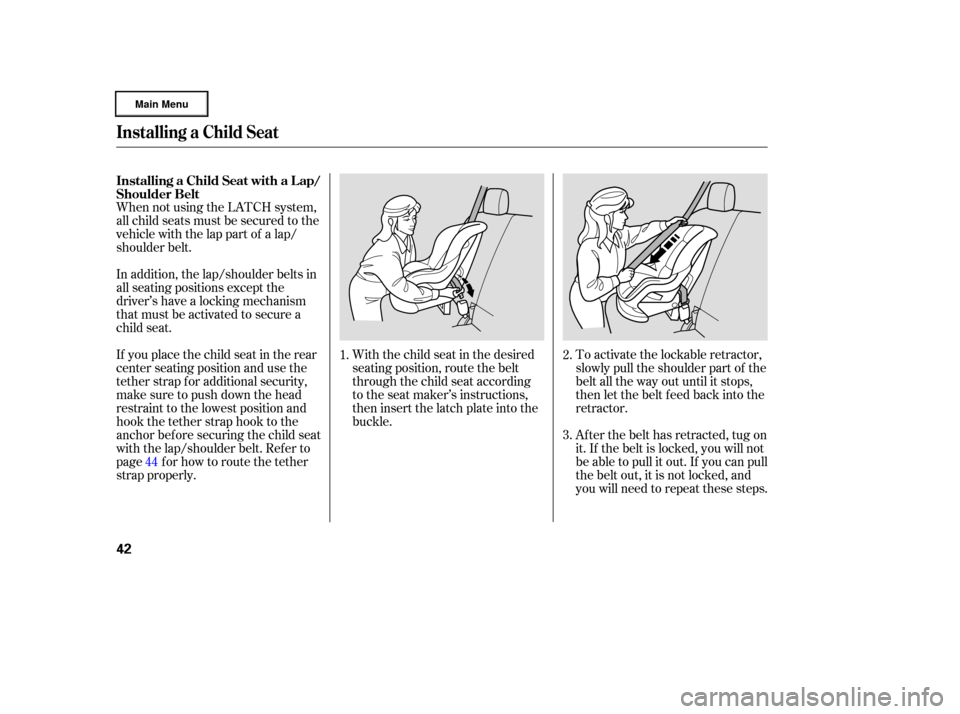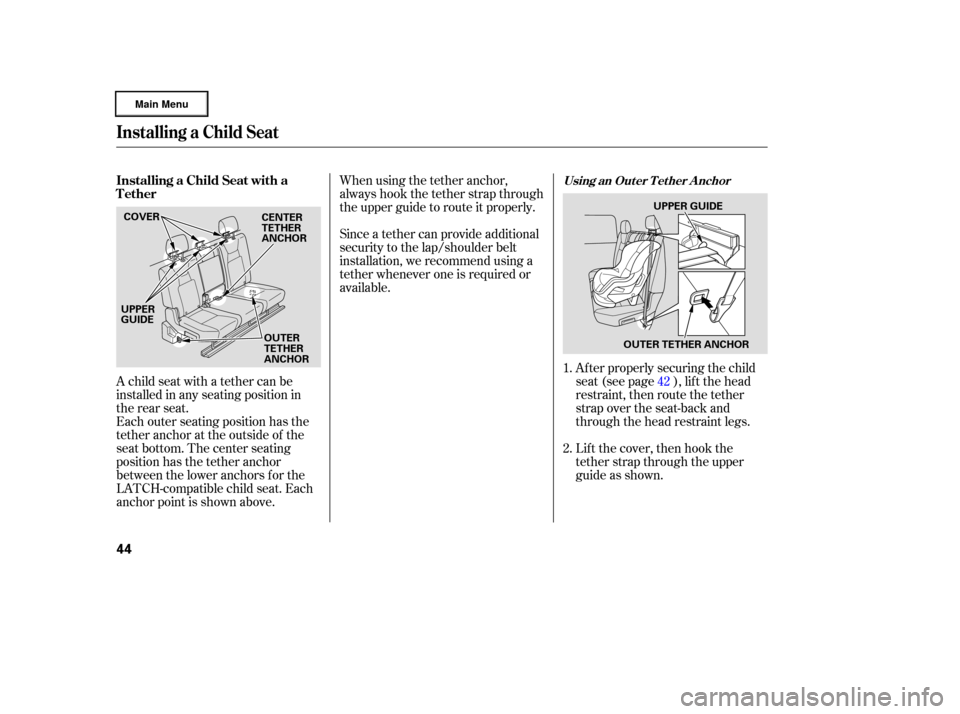Page 44 of 320
Lif t the head restraint (see page), then route the tether strap
over the seat-back and through
the head restraint legs.
Lift the cover, then route the
tether strap around the upper
guide. Route the tether strap
downward properly, making sure
the strap is not twisted, then
attach the strap hook to the tether
anchor on the outside of the seat
bottom (see page ). Push and pull the child seat
f orward and f rom side to side to
verify that it is secure. Tighten the strap according to the
seat maker’s instructions.
6. 7.
8.
99
44
On the outer seating position
Installing a Child Seat
Driver and Passenger Saf ety
41
UPPERGUIDE
Outer Position UPPER
GUIDE
Center Position TETHER ANCHOR
TETHER ANCHOR
�����—�
���—�����y�
������
������y���
�(�����������y���������y
Page 45 of 320

When not using the LATCH system,
all child seats must be secured to the
vehicle with the lap part of a lap/
shoulder belt.With the child seat in the desired
seating position, route the belt
through the child seat according
to the seat maker’s instructions,
then insert the latch plate into the
buckle.To activate the lockable retractor,
slowly pull the shoulder part of the
belt all the way out until it stops,
then let the belt f eed back into the
retractor.
Af ter the belt has retracted, tug on
it. If the belt is locked, you will not
be able to pull it out. If you can pull
thebeltout,itisnotlocked,and
you will need to repeat these steps.
In addition, the lap/shoulder belts in
all seating positions except the
driver’s have a locking mechanism
that must be activated to secure a
child seat.
If you place the child seat in the rear
center seating position and use the
tether strap for additional security,
make sure to push down the head
restraint to the lowest position and
hook the tether strap hook to the
anchor bef ore securing the child seat
with the lap/shoulder belt. Refer to
page for how to route the tether
strap properly.
1. 2.
3.
44
Installing a Child Seat with a L ap/
Shoulder Belt
Installing a Child Seat
42
�����—�
���—�����y�
�������������y���
�(�����������y���������y
Page 46 of 320
Af ter conf irming that the belt is
locked, grab the shoulder part of
the belt near the buckle, and pull
up to remove any slack from the
lap part of the belt. Remember, if
the lap part of the belt is not tight,
the child seat will not be secure.Push and pull the child seat
f orward and f rom side to side to
verify that it is secure enough to
stay upright during normal driving
maneuvers. If the child seat is not
secure, unlatch the belt, allow it to
retract f ully, then repeat these
steps.
To remove slack, it may help to
putweightonthechildseat,or
push on the back of the seat while
pulling up on the belt. To deactivate the locking
mechanism and remove a child seat,
unlatch the buckle, unroute the seat
belt, and let the belt f ully retract.
4. 5.
Installing a Child Seat
Driver and Passenger Saf ety
43
�����—�
���—�����y�
���������
���y���
�(�����������y���������y
Page 47 of 320

When using the tether anchor,
always hook the tether strap through
the upper guide to route it properly.
Since a tether can provide additional
security to the lap/shoulder belt
installation, we recommend using a
tether whenever one is required or
available.
Each outer seating position has the
tether anchor at the outside of the
seat bottom. The center seating
position has the tether anchor
between the lower anchors f or the
LATCH-compatible child seat. Each
anchor point is shown above. A child seat with a tether can be
installed in any seating position in
the rear seat. Lif t the cover, then hook the
tether strap through the upper
guide as shown. Af ter properly securing the child
seat (see page ), lif t the head
restraint, then route the tether
strap over the seat-back and
through the head restraint legs.
1.
2. 42
Installing a Child Seat
Installing a Child Seat with a
TetherUsing an Out er T et her A nchor
44
COVER
UPPER
GUIDE UPPER
GUIDE
CENTER
TETHER
ANCHOR
OUTER
TETHER
ANCHOR OUTER TETHER ANCHOR
�����—�����—�����y�
����
��������y���
�(�����������y���������y
Page 49 of 320
Attach the tether strap hook to the
center tether anchor between the
loweranchorsfortheLATCH-
compatible child seat.Properlysecurethechildseat(see
page ), then tighten the tether
strap according to the seat maker’s
instructions.
Whenever using the tether strap,
make sure to route the strap through
the upper guide bef ore attaching the
tether strap hook to the tether
anchor. If the tether strap is not
routed properly and secured, the
child seat may not be secured. This
could lead to serious injury or death.
5. 6.
42
Installing a Child Seat
46
UPPER GUIDE
CENTER TETHER ANCHOR
�����—�����—�����y�
����
������
�y���
�(�����������y�������
�y
Page 52 of 320

If you decide that a child can saf ely
ride up f ront, be sure to:Caref ully read the owner’s manual,
and make sure you understand all
seat belt instructions and all saf ety
inf ormation.
Move the vehicle seat to the rear-
most position.
Have the child sit up straight, back
against the seat, and feet on or
near the f loor.
Supervise the child. Even mature
children sometimes need to be
reminded to f asten the seat belts
or sit properly. Check that the child’s seat belt is
properly and securely positioned.
Physically, a child must be large
enough f or the lap/shoulder belt to
properly f it (see pages and ). If
the seat belt does not f it properly,
with or without the child sitting on a
booster seat, the child should not sit
in f ront.
To saf ely ride in f ront, a child must
be able to f ollow the rules, including
sitting properly, and wearing the seat
belt properly throughout a ride.
A side airbag also poses risks. If any
part of a larger child’s body is in the
path of a deploying side airbag, the
child could receive possibly serious
injuries. If the passenger’s front airbag
inf lates in a moderate to severe
f rontal collision, the airbag can cause
serious injuries to a child who is
unrestrained, improperly restrained,
sitting too close to the airbag, or out
of position. The National Highway Traffic Safety
Administration and Transport
Canada recommend that all children
age 12 and under be properly
restrained in the back seat. Of course, children vary widely. And
while age may be one indicator of
when a child can saf ely ride in f ront,
there are other important f actors you
should consider.
14 47
Physical Size
Maturity
When Can a L arger Child Sit in
Front
Protecting L arger Children
Driver and Passenger Saf ety
49
�����—�
���—�����y�
���������
���y���
�(�����������y���������y
Page 79 of 320

Push the lever up to lock the
steering wheel in position.
Make sure you have securely
locked the steering wheel in place
by trying to move it up and down.
Make any steering wheel adjustment
bef ore you start driving.
Pushtheredbuttontoturnonthe
hazard warning lights (f our-way
flashers). This causes all four
outside turn signals and both turn
indicators in the instrument panel to
f lash. Use the hazard warning lights
if you need to park in a dangerous
area near heavy traffic, or if your
vehicle is disabled. Move the steering wheel so it
points toward your chest, not
toward your f ace. Make sure you
can see the instrument panel
gauges and indicators. Push the lever on the lef t side of
the steering column all the way
down.3.
4.
1.
2.
Hazard Warning Button, Steering Wheel A djustment
Steering Wheel A djustment
Hazard Warning Button
76
Adjusting the steering wheel
position while driving may
cause you to lose control of the
vehicle and be seriously injured
inacrash.
Adjust the steering wheel only
when the vehicle is stopped.
�����—�
���—�����y�
�������������y���
�(�����������y�������
�y
Page 89 of 320

�µ
�µ �µ
Press this button once
to unlock the driver’s door. Push it
twice to unlock the other doors and
the In-Bed Trunk.
Some exterior and interior lights will
f lash twice each time you push the
button.
When you press the UNLOCK
button, the f ront and rear individual
map lights, depending on the interior
light control switch position, will
come on (see page ). If you do not
open any door, the lights stay on f or
about 30 seconds, then go out. If you
relock the doors and the In-Bed
Trunk with the remote transmitter
bef ore 30 seconds have elapsed, the
lights will go of f immediately.
Press this button once to
lock all doors and the In-Bed Trunk.
Some exterior and interior lights will
flash once.
When you push LOCK twice within 5
seconds, you will hear a beep to
verify that the doors and In-Bed
Trunk are locked and the security
system (if equipped) has set. This
button does not work if any door is
not f ully closed or the key is in the
ignition switch. Press and hold this
button for about 1 second to attract
attention; the horn will sound and
the exterior lights will f lash f or about
30 seconds. To cancel panic mode,
press any other button on the remote
transmitter, or turn the ignition
switch to ON (II). Panic mode does
not work when the key is in the
ignition switch. If you do not open any door within 30
seconds, the doors automatically
relock, and the security system sets
(if equipped). The UNLOCK button
does not work when the key is in the
ignition switch.
You can also open all side windows
f rom outside the vehicle with the
remote transmitter (see page ).
115 104
UNL OCK
LOCK PA NIC
Remote Transmitter
86
LED
UNLOCK
BUTTON
PANIC
BUTTON LOCK
BUTTON
�����—�
���—�����y�
�������������y���
�(�����������y�������
�y